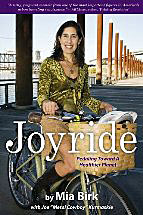Mia Birk’s book Joyride: Pedaling toward a Healthier Planet, is a “how-to manual” for creating a first class bicycle community. Anyone in government or anyone interested in bicycle advocacy would benefit from reading Birk as a way to put their community on the right track to becoming bicycle friendly.
for creating a first class bicycle community. Anyone in government or anyone interested in bicycle advocacy would benefit from reading Birk as a way to put their community on the right track to becoming bicycle friendly.
Birk recounts a perfect storm of events when she became Bicycle Coordinator in Portland in 1993. The US Congress had just funded the first six-year federal transportation package that included a small allocation for “Transportation Enhancements.” “Enhancements” were meant to fund transit, bicycling and walking facilities as Congress attempted to counter the “roads only” policies of state departments of transportation. This enabled states and cities like Fort Collins, Boulder in Colorado and Corvallis, Eugene, and Portland, Oregon to write bicycle plans and to hire bicycle coordinators.
In Portland in 1990 the Bicycle Transportation Alliance (BTA) had been founded, and was to become one of the most active advocacy groups in the nation. Earl Blumenauer, now Congressman from Oregon’s 3rd Congressional District and founder of the Congressional Bike Caucus, was Portland’s Commissioner of Public Utilities. With Blumenauer’s support and with the backing of the BTA Birk set out to make Portland, a city of 500,000 people, a friendlier place to ride a bicycle.
As she explains in Joyride Birk had a series of revelations during the first years of her job that opened her eyes to the challenges she faced. Despite enjoying great support in the bicycle community, she noted that “if I spend my time preachin’ to the gospel choir, the bicycle revolution isn’t going to spread very far.” Additionally, when Portland’s traffic engineers suggested that rather than stripe bicycle lanes, they get the police to enforce the law to encourage more cyclists, she noted “the police won’t even talk to me [as bicycle coordinator] let alone” enforce the rules of the road to protect cyclists.
Another revelation came after her third annual bike to work day when Birk asked herself, “is this helping to get more people out riding? Is my time best spent running events like this, or working on bikeway projects?” The answer, she found, was that she needed to mobilize the non-bicyclists in town, build bike paths and lanes, and to become more of a catalyst in bringing people together to change the culture in order to get reluctant cyclists on their bikes. “It’s not enough to adopt a Bicycle Plan” she wrote, “we’ve got to retrain all the humans involved, both inside and outside government.”
So Birk began with neighborhood meetings at Denny’s. Then she met with the Lions Club. Once she was fully underway she was meeting with “business groups, ethnic groups, neighborhood associations, school groups, churches” and as she explains it, “pretty much anyone who” would listen in a series of sixty meetings across Portland.
The results of Birk’s work are impressive to the degree that Joyride should be required reading for anyone who wants to see bicycle ridership increase in their community.

